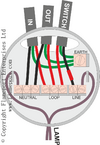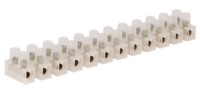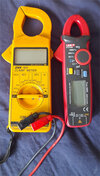- Joined
- 16 May 2024
- Messages
- 96
- Reaction score
- 1
- Country

So rule one of taking a photo pre light removal was not done. First Lighting DIY project. Wont make the same mistake again.
I Replaced 2 ceiling lights (Kitchen and diner) assumed it was easy.
The wires identified are noted in the image below.
The lights had multiple live (Red) and what I assumed neutral (black) (before discovering what a switched live was)
So I attached lives to the "L" port on the lights. and Neutrals to the "N" Port. Earth to the earth port. (Excluded from diagram)
Worked fine before. But now the living room light doesnt come on (didnt change this light)
And for some reason the living room light switch turns both the kitchen diner lights on and off.
The kitchen 2 gang does nothing. But I can tell the feed runs from living room switch through the kitchen switch to the lights. (taking out bridge kills the whole thing)
I dont know which light is first or last in the sequence.
I assume some of the neutrals I put in the neutral ports on the lights. Were infact switched lives and now the kitchen switch is bypassed?.
Is this dangerous to play around with? I purchased a mulitmeter and am awaiting extended wires so I can find out where these wires start and end.
Oddly there are black wires leaving the lights. But all red at switch.
I'm confused... any advice? Am at risk of starting a fire when turning these on currently?
What you see below is all I see. Wires going to lights from ceiling and leaving switch

I Replaced 2 ceiling lights (Kitchen and diner) assumed it was easy.
The wires identified are noted in the image below.
The lights had multiple live (Red) and what I assumed neutral (black) (before discovering what a switched live was)
So I attached lives to the "L" port on the lights. and Neutrals to the "N" Port. Earth to the earth port. (Excluded from diagram)
Worked fine before. But now the living room light doesnt come on (didnt change this light)
And for some reason the living room light switch turns both the kitchen diner lights on and off.
The kitchen 2 gang does nothing. But I can tell the feed runs from living room switch through the kitchen switch to the lights. (taking out bridge kills the whole thing)
I dont know which light is first or last in the sequence.
I assume some of the neutrals I put in the neutral ports on the lights. Were infact switched lives and now the kitchen switch is bypassed?.
Is this dangerous to play around with? I purchased a mulitmeter and am awaiting extended wires so I can find out where these wires start and end.
Oddly there are black wires leaving the lights. But all red at switch.
I'm confused... any advice? Am at risk of starting a fire when turning these on currently?
What you see below is all I see. Wires going to lights from ceiling and leaving switch
Last edited:



